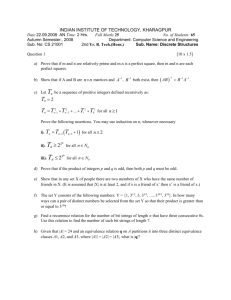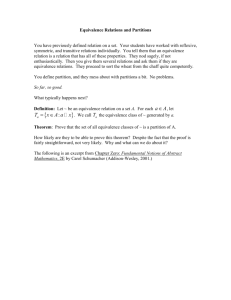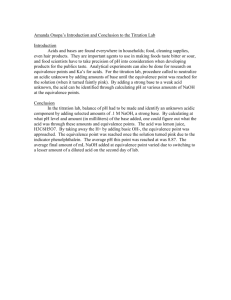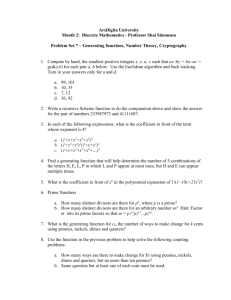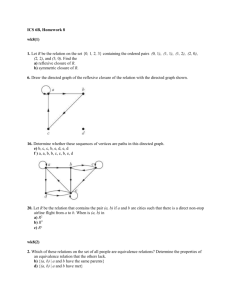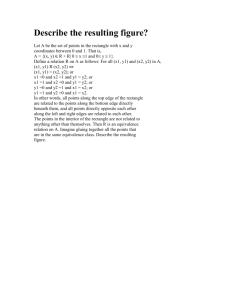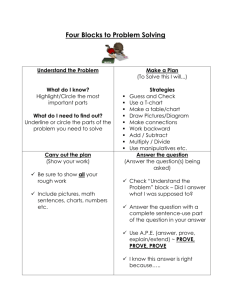Botta, R., Bahill, Z., and Bahill, T. Observable States may be
advertisement
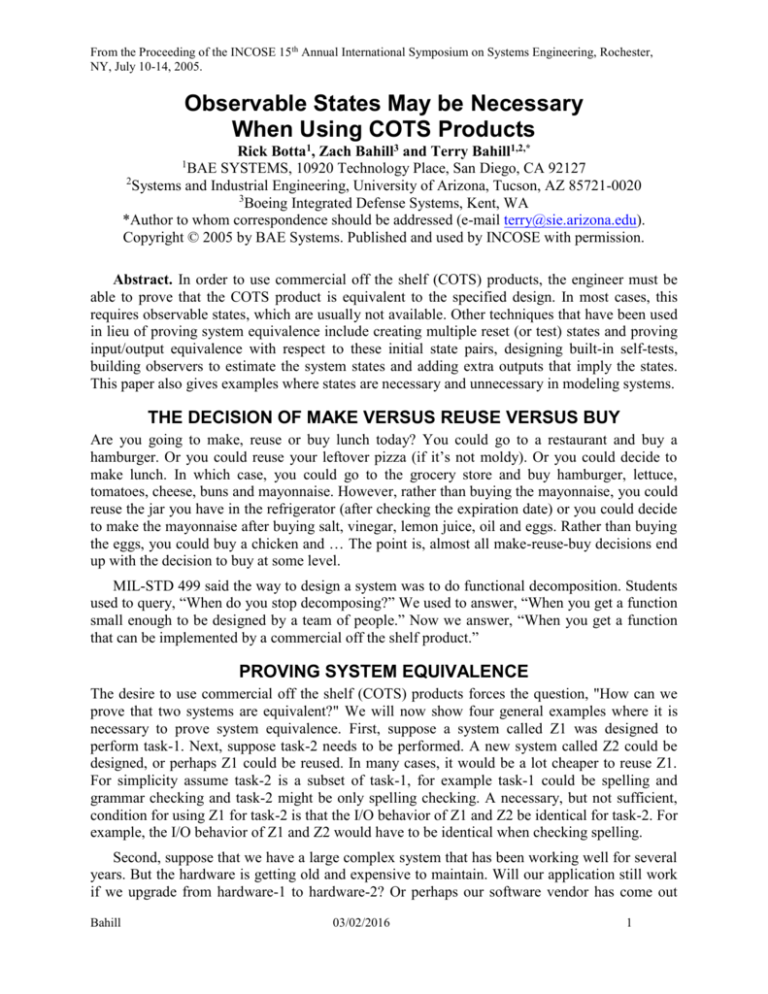
From the Proceeding of the INCOSE 15th Annual International Symposium on Systems Engineering, Rochester,
NY, July 10-14, 2005.
Observable States May be Necessary
When Using COTS Products
Rick Botta1, Zach Bahill3 and Terry Bahill1,2,*
BAE SYSTEMS, 10920 Technology Place, San Diego, CA 92127
2
Systems and Industrial Engineering, University of Arizona, Tucson, AZ 85721-0020
3
Boeing Integrated Defense Systems, Kent, WA
*Author to whom correspondence should be addressed (e-mail terry@sie.arizona.edu).
Copyright © 2005 by BAE Systems. Published and used by INCOSE with permission.
1
Abstract. In order to use commercial off the shelf (COTS) products, the engineer must be
able to prove that the COTS product is equivalent to the specified design. In most cases, this
requires observable states, which are usually not available. Other techniques that have been used
in lieu of proving system equivalence include creating multiple reset (or test) states and proving
input/output equivalence with respect to these initial state pairs, designing built-in self-tests,
building observers to estimate the system states and adding extra outputs that imply the states.
This paper also gives examples where states are necessary and unnecessary in modeling systems.
THE DECISION OF MAKE VERSUS REUSE VERSUS BUY
Are you going to make, reuse or buy lunch today? You could go to a restaurant and buy a
hamburger. Or you could reuse your leftover pizza (if it’s not moldy). Or you could decide to
make lunch. In which case, you could go to the grocery store and buy hamburger, lettuce,
tomatoes, cheese, buns and mayonnaise. However, rather than buying the mayonnaise, you could
reuse the jar you have in the refrigerator (after checking the expiration date) or you could decide
to make the mayonnaise after buying salt, vinegar, lemon juice, oil and eggs. Rather than buying
the eggs, you could buy a chicken and … The point is, almost all make-reuse-buy decisions end
up with the decision to buy at some level.
MIL-STD 499 said the way to design a system was to do functional decomposition. Students
used to query, “When do you stop decomposing?” We used to answer, “When you get a function
small enough to be designed by a team of people.” Now we answer, “When you get a function
that can be implemented by a commercial off the shelf product.”
PROVING SYSTEM EQUIVALENCE
The desire to use commercial off the shelf (COTS) products forces the question, "How can we
prove that two systems are equivalent?" We will now show four general examples where it is
necessary to prove system equivalence. First, suppose a system called Z1 was designed to
perform task-1. Next, suppose task-2 needs to be performed. A new system called Z2 could be
designed, or perhaps Z1 could be reused. In many cases, it would be a lot cheaper to reuse Z1.
For simplicity assume task-2 is a subset of task-1, for example task-1 could be spelling and
grammar checking and task-2 might be only spelling checking. A necessary, but not sufficient,
condition for using Z1 for task-2 is that the I/O behavior of Z1 and Z2 be identical for task-2. For
example, the I/O behavior of Z1 and Z2 would have to be identical when checking spelling.
Second, suppose that we have a large complex system that has been working well for several
years. But the hardware is getting old and expensive to maintain. Will our application still work
if we upgrade from hardware-1 to hardware-2? Or perhaps our software vendor has come out
Bahill
03/02/2016
1
From the Proceeding of the INCOSE 15th Annual International Symposium on Systems Engineering, Rochester,
NY, July 10-14, 2005.
with a new version. Other sites have upgraded, but we have not, so we are losing compatibility.
Will our application still work if we upgrade from software-1 to software-2? A necessary but not
sufficient condition for success of the upgrade is that the input/output behavior of the application
be the same on the old system as it is on the new system.
Third, suppose we make custom systems for our customer. They work very well, but they are
expensive. Now our customer wants us to design a new system, but to keep the cost down, he
wants us to use as many commercial-off-the-shelf products as possible. We have a design, Z1,
which satisfies the customer's needed functionality. But we want to know if a COTS system, Z2,
will also satisfy this functionality.
A very common technique for describing the desired behavior of a system is to describe
acceptable input/output trajectories (scenarios) for the system. Such descriptions of input and
output behavior as functions of time are variously called trajectories, strings, behavioral
scenarios, use cases, threads, operational scenarios, logistics, functionality, test vectors, sequence
diagrams or interaction diagrams. When using such techniques the following question often
arises, "How do you know when you have enough scenarios?" The answer seems to be never.
Because merely looking at input/output behavior can never guarantee correct system behavior:
we must be able to observe the states.
Fourth, system verification often requires observable states. Suppose Engineering designs a
system, then Manufacturing builds a physical system. Could an engineer prove that the physical
system implements the design? If the states were observable, then the engineer could construct
an input trajectory (scenario) that exercised all state transitions, apply this input trajectory to both
systems and compare the resulting state trajectories. If they were identical, then the systems
would be equivalent. However, if the system states were not observable, then the only thing the
engineer could work with is the input/output behavior of the systems. Wymore and Bahill (2000)
proved that identical input/output behavior is not sufficient for proving equivalence of two statebased systems.
Suppose an engineer tried to implement the design Z3 in, say, TTL circuitry. How could he
or she test this hardware to prove that it did indeed implement the design? If the states were
observable, then the engineer could construct an input trajectory (scenario) (or a set of input
trajectories) that exercised all state transitions, apply this input trajectory to Z3 and to the TTL
circuit, and compare the resulting state trajectories. If they were identical, then the systems
would be equivalent. However, what if the states were not observable? Well, then the engineer
could set each state as an initial state and then prove I/O equivalence with respect to each initial
state pair (Wymore and Bahill, 2000). Finally, what if you cannot put the system into all possible
initial states? Then you cannot prove system equivalence!
We have just mentioned four reasons why engineers might want to prove that two systems
are equivalent: 1) desire to reuse existing systems, 2) plans to upgrade systems, 3) desire to use
commercial off-the-shelf (COTS) systems and 4) the need to verify that a physical system
conforms to its design. Of course, there are many more reasons. One of the best ways to prove
system equivalence is to design an input trajectory (scenario) (or perhaps a set of input
trajectories) that exercises every possible state transition, apply it to both systems and ensure that
the two state trajectories are identical. However, this might be impossible, because the states are
not observable: or it might be too expensive, due to the large number of states.
Bahill
03/02/2016
2
From the Proceeding of the INCOSE 15th Annual International Symposium on Systems Engineering, Rochester,
NY, July 10-14, 2005.
Here are some other techniques that have been used in lieu of proving system equivalence.
(1) Create multiple reset (or test) states and prove I/O equivalence with respect to an initial state
pair for all of them. These reset states must be precise. Each system must go into a well defined
reset state when ever the reset signal is received no matter what it was doing or what state it was
in. Ctrl-C guaranteed termination of DOS programs. Ctrl-Alt-Delete put the system into a unique
reset state for early Windows systems. Now, turning the power off for at least one minute usually
produces a reset state for modern Windows systems. (2) Design built-in self-tests. The built-in
self-tests should verify that the systems satisfy certain requirements. If the same requirements are
being verified for both systems, then partial equivalence is being demonstrated. (3) Only use
COTS products in places where you do not care about observable states. For example, in an
interface that passes data from a high security system to a low security system. As long as it
passes the needed information, we do not care what happens internally. (4) Build an observer to
estimate the system states. This technique is common in the field of Linear Systems Theory
(Szidarovszky and Bahill, 1997). In a sense, it is similar to the following technique. (5) Add
extra outputs so that the states can be identified by examining the outputs.
Example of Adding Outputs. In the old days, accelerometers from automobile air bag systems
indicated their state as Ready or Fired. At the same time, missile manufactures spent thousands
of dollars on g-switches that indicated when a missile had accelerated away from its platform.
Then someone added an extra output to the accelerometers, an output that indicated the state of
the accelerometer -- its present acceleration. Missile manufactures then started using these
inexpensive accelerometers in missile safing systems instead of expensive custom made gswitches. The following figures show how UML represents the state of an object in a state
machine diagram and with the values of its attributes in a class diagram.
Air Bags
Have Fired
AirBagAccelerometer
presentAcceleration
senseAcceleration()
triggerAirbags()
g-ThresholdExceeded/
explodeAzide
Air Bags
Are Ready
Figure 1. State machine diagram (left) and a class diagram (right) showing how states are
represented. The class diagram has three compartments containing the class name (top),
attributes in this case indicating the state (middle) and functions (bottom). Copyright ,
2005, Bahill, from http://www/sie.arizona.edu/sysengr/slides/ used with permission.
SOMETIMES IT WORKS
Input/output (I/O) equivalence cannot be used to prove the equivalence of two dynamic systems.
But many engineers say that this is how they do it. Whenever a lot of people say that they do
something that cannot be done, it is useful to examine exactly what they are doing. First, they are
Bahill
03/02/2016
3
From the Proceeding of the INCOSE 15th Annual International Symposium on Systems Engineering, Rochester,
NY, July 10-14, 2005.
using input/output behavior to prove system equivalence and sometimes it works. So, next we
want to show under what circumstances it works.
In the field of Digital Design (e.g. computer design), the two basic types of systems are
called combinational and sequential [Katz, 1993]. In the field of cybernetics, Van Foerster
[1982] called them, respectively, trivial and nontrivial systems. In this paper, we will call them
memoryless and dynamic. In memoryless systems, the output depends only on the present inputs.
Whereas, in dynamic systems the output depends on the sequence of previous inputs.
Memoryless problems can be modeled and implemented as dynamic systems. But not vice versa.
Consider a household three-way light system with one light and two switches, one at each
end of a hallway. Define the inputs to be the position of the switches {up, down}.
S1
S2
Figure 2. Wiring diagram for a three-way light system. Copyright , 2005, Bahill, from
http://www/sie.arizona.edu/sysengr/slides/ used with permission.
We can create the following dynamic model for this three-way light system.
S1up-S2up
[on]
up, up
up, down
down, up
up, up
S1up-S2down
[off]
S1down-S2up
[off]
down, down
down, up
up, down
Simultaneous switching
is not shown
S1down-S2down
[on]
down, down
Figure 3. State machine model for a three-way light system. Copyright , 2005, Bahill,
from http://www/sie.arizona.edu/sysengr/slides/ used with permission.
For simplicity, input combinations that do not produce a change of state are not shown; also,
simultaneous changes of both switches are not shown.
Given the present state and an input trajectory (sequence of inputs), we can compute the state
trajectory. Therefore, the three-way light system can be modeled as a dynamic system as in the
above figure and it can be implemented with flip-flops.
Bahill
03/02/2016
4
From the Proceeding of the INCOSE 15th Annual International Symposium on Systems Engineering, Rochester,
NY, July 10-14, 2005.
However, in actuality, the three-way light system is a memoryless problem: it does not need
a dynamic solution. The present state depends only on the present positions of the switches. The
system can be modeled with the truth table of Table I.
Table I. A Truth Table
S2
S1
Light
down
down
on
down
up
off
up
down
off
up
up
on
From this Table I, we can derive the following Boolean equation:
Light S1 S 2 S1 S 2
This equation (or model) can be implemented using only AND and OR gates. This
memoryless system implementation is simpler than the dynamic system implementation
presented above. Furthermore, the equivalence of this memoryless model with the physical
system can be proven using only input/output behavior.
Contrast this three-way light system with a three-way lamp that can be off, on at 50 watts, on
at 100 watts or on at 150 watts. Turn the switch 90 degrees, and the lamp is on dimly. Turn it
again, and the lamp is on with medium brightness. Turn it a third time and the lamp is on
brightly. A final turn, turns the lamp off. The behavior of this system (with its only input of turn
90 degrees) clearly depends on its previous state: it is a dynamic problem and it requires a
dynamic solution. The equivalence of the dynamic solution (model) with the physical system
cannot be proven using only input/output behavior.
Therefore, in the real world, there are memoryless problems that should have memoryless
solutions: however, they could also have dynamic solutions. An engineer can prove the
equivalence of these memoryless problems using only input/output behavior. However, realworld dynamic problems must have dynamic solutions. And the equivalence of these solutions
cannot be proven using only input/output behavior.
In this paper, we have shown that an engineer cannot prove equivalence of two dynamic
systems using only input/output behavior. But there are many engineers who say that they have
proven the equivalence two systems using only input/output behavior. We suggest that their
systems were merely memoryless problems. And for memoryless problems, equivalence can be
proven using only input/output behavior.
WHAT TYPE OF SYSTEMS HAVE STATES AND
WHAT TYPE OF MODELS NEED STATES?
In order to use COTS products we must have a valid model of the system that has observable
states in order to prove that the model conforms to the system design.
Before analyzing models of systems, we need a definition of a system. A system is a
combination of interacting elements that perform a function not possible with any of the
individual elements. The elements can include hardware, software, bioware, facilities, policies
and processes. A system accepts inputs, over which it has no direct control, and transforms them
Bahill
03/02/2016
5
From the Proceeding of the INCOSE 15th Annual International Symposium on Systems Engineering, Rochester,
NY, July 10-14, 2005.
into outputs. A system should have a well-defined boundary. Fitting this single definition are
many types of systems, some have states and some do not.
Systems can be categorized as memoryless or dynamic. In a memoryless system, the outputs
depend only on the present values of its inputs. Whereas, in a dynamic system the outputs depend
on the present and past values of its inputs. For dynamic systems, we must define the concept of
a state.
The state of a system makes the system’s history irrelevant. The state of the system contains
all of the information needed to calculate future responses without reference to the past history of
inputs and outputs. The state of the system, the present inputs and the sequence of future inputs
allow computation of all future states (and outputs). For example, the present balance of your
checking account can be the state of that system. This state could have gotten to its present value
in many ways, but when you write a check, that history is irrelevant. But of course, your model
depends on how you define your system. Credit agencies would want to know how many times
you had a negative balance and the bank would want to know your daily balance in order to
calculate your interest.
Some dynamic systems are modeled best with state equations while others are modeled best
with state machines. State-equation systems are modeled with equations. For example, a
baseball’s movement can be modeled with state equations for position, linear velocity and
angular velocity all as functions of time. State-machine systems focus less on physical variables
and more on logical attributes. Therefore, these systems have memory and are modeled with
finite state machines. Most computer systems are modeled with finite state machines.
At each instant of time, a dynamic system is in a specific state. State-equation systems can
have one or many state variables: at any time, the system’s state is defined as the unique values
for each of the state variables. State-machine systems can be modeled with one or many
concurrent state machines: at any time, each state machine must be in one and only one state. A
state is a unique snapshot that (1) is specified by values for a set of variables, (2) characterizes
the system for a period of time and (3) is different from other states. Each state is different from
other states in either the inputs it responds to, the outputs it produces or the transitions it takes. A
transition is a response to an input that may cause a change of state.
In modeling a system, one of the most important tasks is deciding whether the system is
memoryless or dynamic. First, let us consider some state-equation systems. An ideal spring is a
memoryless system, because the output position depends only on the input force applied.
Whereas, an ideal mass is a dynamic system, because the output position depends on the applied
input force as well as the initial position and velocity. An ideal resistor is a memoryless system,
because the output voltage depends only on the input current. Whereas, a resistor-capacitor
system is dynamic, because the output voltage depends on the input current as well as the initial
capacitor voltage.
Let us now consider some game systems and decide whether they are memoryless or
dynamic. Roulette is a memoryless system. You spin the wheel, look at the input and pay the
output. State lotteries are also memoryless systems. The State does not care who won last week:
it just draws the numbers and pays the winners. Flipping a coin is memoryless. The card game
Show Low is a memoryless game. Each player cuts the deck and shows his card. The player
showing the lowest card wins. The city of Show Low in Arizona was named after a famous
Show Low game. A padlock is a memoryless system: whereas, a combination lock is a dynamic
Bahill
03/02/2016
6
From the Proceeding of the INCOSE 15th Annual International Symposium on Systems Engineering, Rochester,
NY, July 10-14, 2005.
system. The game of Craps requires knowledge of “the point.” So it is a dynamic system, but
because it requires memory of only one number, it is one of the simplest dynamic games.
Often a question will help you discover the state information that a dynamic system must
store in its memory. For instance, if you are playing a game of chess by mail, “What state
information does your opponent need in order to respond to your move?” He or she would need
to know the position of every piece on the board, whose turn it is, whether or not each person has
castled, and about passed pawns. We will now estimate the information complexity of this game
by suggesting how much memory this would require. The location of each piece could be
prescribed by noting its row and column. For example white’s bishop in column d, row 5 would
be WBd5. There are 32 pieces each requiring 4 bytes. So the game would require about 140
bytes. Near the end of a game individual moves would also have to be recorded to possibly
indicate a stalemate.
For checkers you would need to record the color and type of each piece on the 32 numbered
squares. Information complexity is 96 bytes.
If a baseball game were called due to rain, “What state information would you have to store
in order to restart it at a later date?” You would need to store total runs scored by the visiting
team, total runs scored by the home team, the inning, whether it is the top or the bottom of the
inning, last batter for the visiting team, last batter for the home team, outs in this half of the
present inning, balls on present batter, strikes on present batter, name of runner on first base,
name of runner on second base, name of runner on third base, and a list of players who have
been removed from the game (this is important, because in baseball a removed player cannot
return). You would need all this state information in order to restart a rain-delayed game. For
information complexity, this is about 120 bytes. If you wish, you might also consider some
esoteric states such as the batting order and the number of times each manager and coach has
gone out to talk to the pitcher in the inning. For Little League games you might want to list how
many innings each pitcher pitched (pitchers are limited to six innings per week) and the children
who were in attendance (children who were not there for the original game cannot play in the
resumed game).
Poker is a very complex dynamic system. Before you make a bet, you should know all of the
cards that have been played, all of the bets that have been made and the state of each opponent’s
mind. To assess their states of mind, you must read their body language and use this in
combination with their previous betting patterns. Poker requires astute observation and a large
memory to store a large number of states.
In contrast, Blackjack is a much simpler dynamic system, because you are only playing
against the dealer and the dealer must abide by strict rules. So the only state information you
need is the cards that have been played. For information complexity, on average 26 cards would
have been played and you can record each card with 2 bytes of information. So information
complexity is about 50 bytes.
Bahill
03/02/2016
7
From the Proceeding of the INCOSE 15th Annual International Symposium on Systems Engineering, Rochester,
NY, July 10-14, 2005.
Table II. For which systems are states needed?
Game
Are States Needed State Information
Needed?
Roulette
No
None
Coin Toss
No
None
Lottery
No
None
Craps
Yes
The point
Blackjack
Yes
Cards that have been played from the deck
Checkers
Yes
Identity of piece on each square, Who’s turn
Baseball
Yes
Batter, inning, count, score, etc.
Chess
Yes
Position of each piece, Castling, Stalemates, Passed
pawns, Who’s move
Poker
Yes
Bets, Cards in deck, Previous behavior
A computer is obviously a dynamic system. If you buy a new computer or install a new
operating system, you should record the parameters of your dialup modem, favorite URLs of
your browser, custom dictionary of your spelling checker, version and preferences for all
software. These partially capture the state of your previous system.
Almost any system containing a microprocessor will be a dynamic system: microwave ovens,
cars, watches, calculators, printers, telephones. Simple models for most inanimate objects will be
memoryless systems: chairs, desks, mugs, staplers, bats and balls. But, of course, your purpose in
modeling the system may force you to sometimes use a dynamic model. For example, it might be
important if the stapler had staples in it. The coefficient of restitution of a bat-ball collision
depends upon the internal temperature of the ball, and this would depend on its history, for
example, if it had been stored in a freezer.
We now want to consider some commercial database systems. Are DOORS and Excel
essentially equivalent systems? Yes, for most practical purposes. They have different features,
but for creating a simple requirements system, they are equivalent, because the programs
themselves do not have significant state behavior. How would you prove the equivalence of a
DOORS requirements system and an Excel requirements system? First, you would compare the
contents of each memory cell. If they were all equal, then the databases would be equivalent.
Then you could merge two Excel databases and two DOORS databases and recheck for
equivalence. Then you could delete of all requirements containing a certain keyword from an
Excel database and a DOORS database and then compare the resulting databases of each system
requirement by requirement. Similar statements should hold for SQY, Sybase and Oracle
requirements systems.
The above paragraph about DOORS and Excel is different from the rest of this paper. The
rest of this paper was precise. This paragraph is mushy. It was put in to show the type of
decisions engineers frequently make. Most engineers would be willing to upgrade an Excel
spreadsheet to a DOORS database and they would seldom get into trouble doing so. Although
they would not have proven that such an upgrade would be valid.
Bahill
03/02/2016
8
From the Proceeding of the INCOSE 15th Annual International Symposium on Systems Engineering, Rochester,
NY, July 10-14, 2005.
SUMMARY
If we are to use a COTS product in our new system design, we will have to find a way to prove
that the COTS product is equivalent to its design. First, we need to decide if the COTS product is
memoryless or dynamic. If it is memoryless, we can apply a string of inputs to both the COTS
product and its design model and observe the string of outputs. If they are the same, then the
COTS product is equivalent to the design model. However, if the COTS product is a dynamic
system, then we must ask if the states are observable. If they are, we can design system
experiments where we start the COTS product and the design model in the same state, apply a
string of inputs and observe the resulting string of states. If we do this rigorously, we can prove
that they are equivalent. However, if the states are not observable, then we need some other
technique to assure that the behavior of the COTS product is acceptable. Here are some other
techniques that have been used in lieu of proving system equivalence. (1) Create multiple reset
(or test) states and prove I/O equivalence with respect to these initial state pairs. (2) Build an
observer to estimate the system states. (3) Add extra outputs that help estimate the states. (4)
Design built-in self-tests. These techniques do not prove equivalence of the COTS product and
the design, but they do give some assurance that the COTS product is behaving as it should.
The equivalence of two systems can be proven using input/output behavior for memoryless
systems, but not for dynamic systems. The equivalence of dynamic systems can only be proven
by observing the string of states, which means that the systems must have observable states. So
before trying to prove system equivalence, we must decide whether the systems are memoryless
or dynamic; and if they are dynamic, we must ensure that the states are observable.
REFERENCES
J. Daniels, P. W. Werner and A. T. Bahill, Quantitative Methods for Tradeoff Analyses, Systems
Engineering: the Journal of INCOSE, 4(3), 199-212, 2001.
R. H. Katz, Contemporary Logic Design, Benjamin/Cummings Publishing Co., Redwood City,
1994.
F. von Foerster, Observing Systems, Intersystems publications, Seaside, 1982.
F. Szidarovszky and A. T. Bahill, Linear Systems Theory, CRC Press Inc., Boca Raton, FL,
1997.
A. W. Wymore and A. T. Bahill, When can we safely reuse systems, upgrade systems or use
COTS components? Systems Engineering, 3(2), 82-95, 2000.
Biographies
Rick Botta is the Director of Systems Engineering for BAE Systems National Security
Solutions in San Diego. He holds a Bachelor of Science degree in Computer Science from
California Polytechnic State University, San Luis Obispo. Rick has a quarter century experience
in a wide variety of engineering, engineering management and program management roles
involving development and integration of complex, software intensive systems. He is a member
of INCOSE.
Zach Bahill is a systems engineer with Boeing Integrated Defense Systems in Kent, WA. He
earned a B. S. Electrical Engineering in 2001 from the Department of Electrical and Computer
Engineering at the University of Arizona, Tucson.
Bahill
03/02/2016
9
From the Proceeding of the INCOSE 15th Annual International Symposium on Systems Engineering, Rochester,
NY, July 10-14, 2005.
Terry Bahill is a Professor of Systems Engineering at the University of Arizona in Tucson.
While on sabbatical from the University of Arizona, he is doing research with BAE Systems in
San Diego. He received his Ph.D. in electrical engineering and computer science from the
University of California, Berkeley, in 1975. Bahill has worked with BAE Systems in San Diego,
Hughes Missile Systems in Tucson, Sandia Laboratories in Albuquerque, Lockheed Martin
Tactical Defense Systems in Eagan MN, Boeing Information, Space and Defense Systems in
Kent, WA, Idaho National Engineering and Environmental Laboratory in Idaho Falls and
Raytheon Missile Systems in Tucson. For these companies he presented seminars on Systems
Engineering, worked on system development teams and helped them describe their Systems
Engineering Process. He holds a U.S. patent for the Bat Chooser, a system that computes the
Ideal Bat Weight for individual baseball and softball batters. He is a Fellow of the Institute of
Electrical and Electronics Engineers (IEEE) and of the International Council on Systems
Engineering (INCOSE). He is the Founding Chair Emeritus of the INCOSE Fellows Selection
Committee.
Bahill
03/02/2016
10
